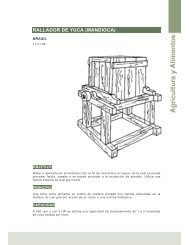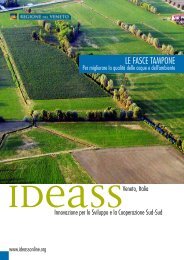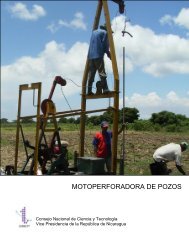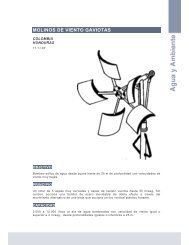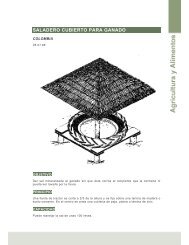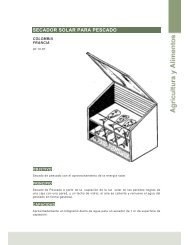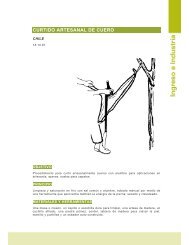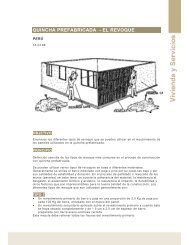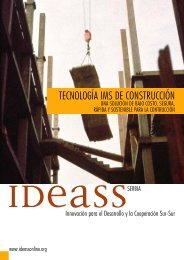Agricultural towers for multi-level cultivation - European BIC Network
Agricultural towers for multi-level cultivation - European BIC Network
Agricultural towers for multi-level cultivation - European BIC Network
You also want an ePaper? Increase the reach of your titles
YUMPU automatically turns print PDFs into web optimized ePapers that Google loves.
<strong>Agricultural</strong> <strong>towers</strong> <strong>for</strong> <strong>multi</strong>-<strong>level</strong> <strong>cultivation</strong><br />
ideassFRANCE<br />
Innovation <strong>for</strong> Development and South-South Cooperation<br />
www.ideassonline.org
Introduction<br />
by Jean-Claude Rey<br />
The agricultural <strong>towers</strong> <strong>for</strong> <strong>multi</strong>-<strong>level</strong> <strong>cultivation</strong> allow to increase the <strong>cultivation</strong> surface area and need a<br />
minimum of maintenance. They simplify the control and enriching of the soil <strong>for</strong> a truly organic farming. Thanks<br />
to their <strong>multi</strong><strong>level</strong> design, they limit plant aggressions and can be covered by nets to increase the protection<br />
against flying insects. They can be modified to fit the ground on which they are build and to optimize the control<br />
of water, using only the strict minimum. They run entirely on solar energy which is clean, renewable and free,<br />
also allowing alimentation to other structures, such as preserve farms, health centers, schools, etc.<br />
For the first time, the garden, its operating energy and its water are all in the same place. Thanks to their<br />
self-sufficiency, these structures allow rain water storage in tanks and also, if desired, the local distribution of<br />
drinking water to surrounding populations, improving their living conditions.<br />
With a permanent cultivating cycle, the<br />
production excess and the seasonal local production<br />
can be sold, thus creating economic and social<br />
hubs. These <strong>towers</strong> don't impose the <strong>cultivation</strong> of<br />
any particular crop or upset habits, lifestyles and<br />
customs. It’s easy to protect them from intruders.<br />
Adapted to every need (cultivating, precultivating,<br />
tree nurseries, experimentation, etc.),<br />
the agricultural tower is totally independent and<br />
can even provide energy above its own needs.<br />
The success of this innovation was made possible<br />
with the support of the EBN network – <strong>European</strong><br />
Innovation Centers <strong>Network</strong> – and the Business<br />
Innovation Center Thésame in Annecy (France)<br />
following the values of sustainable development.<br />
These <strong>multi</strong><strong>level</strong> <strong>towers</strong> are patented and have<br />
won many international prizes. In January 2010<br />
they got the first prize of the EBN-UNDP IDEASS<br />
competition <strong>for</strong> innovation in human development<br />
oriented towards technologies in sustainable<br />
development.
What problem does it solve?<br />
<strong>Agricultural</strong> <strong>towers</strong> are an answer to the<br />
management and preservation of water and soil.<br />
They provide solutions <strong>for</strong> the lack of cultivable<br />
grounds and use solar energy. The loss of cultivable<br />
grounds is as much a problem <strong>for</strong> rich and<br />
industrialized countries as <strong>for</strong> poor countries around<br />
the globe. The main purpose of these <strong>towers</strong> is to<br />
allow local populations in developing countries to be<br />
self-sufficient with the production and preservation<br />
of their food, optimizing their use of water.<br />
The main objective of this innovation is to<br />
deal with water shortage, collecting rain water<br />
and watering excess in order to water the different<br />
<strong>level</strong>s of <strong>cultivation</strong>. The roof collects rain water,<br />
protects crops from violent storms, hail or strong<br />
sunlight. The raised tubs keep rodents and other<br />
crawling animals away, the crops are untouched<br />
by accidental liquid or solid pollution and it's now<br />
possible to work in an upright position.<br />
<strong>Agricultural</strong> <strong>towers</strong> generate social and economic hubs; they are an answer to rural<br />
exodus avoiding depopulation. They become a staging post <strong>for</strong> nomadic people assured to<br />
find water, food and energy.<br />
These <strong>towers</strong> generate employment and improve local economies by creating short<br />
supply chains. This technology employs local labour capable of working in the <strong>towers</strong>. The<br />
local populations are trained <strong>for</strong> the setup and the maintenance of these installations.<br />
P3
Photo A<br />
<strong>Agricultural</strong> <strong>towers</strong> in practice<br />
Photo E<br />
The devices <strong>for</strong> the watering system are fed by a solar panel<br />
fixed on the tower's roof which, due to the battery, is selfsufficient<br />
in energy. The number of solar panels can be increased<br />
to meet other needs. (Photo A)<br />
Photo B<br />
The semi-closed watering system is run by an electronic card<br />
placed in an electric box which also protects the battery and the<br />
pump. The system provides different watering modes: drop by<br />
drop, in a continuous flow or through the bottom of the tub. A<br />
computerized water control system makes it possible to meet the<br />
precise needs of every type of crop.<br />
The programmer placed on the front of the box enables<br />
a quick access to the watering program, frequency, duration.<br />
(Photo D, E)<br />
Photo D<br />
The roof protects the crops from bad weather and hail<br />
storms. It also permits the recovery of rain water which,<br />
through an independent circuit, runs down into a tank placed<br />
under the tower, providing a free, permanent and renewable<br />
water supply. (Photo B)<br />
This supply can be increased by the choice of a larger tank<br />
and/or the boring of a well under the tower during its set up.<br />
The tower is then self-sufficient, its water being pumped on<br />
demand by a semi closed regulation system described in the<br />
following paragraph. The tanks are closed off from any exterior<br />
pollution. (Photo C)<br />
Photo C<br />
A warning light will indicate a possible lack of water. The<br />
watering task being no longer necessary, your staff will be<br />
available <strong>for</strong> more productive work. It is also possible to add<br />
to the watering system a parallel treating system, collecting the<br />
watering excess in a separate tank with no risk of pollution of<br />
surrounding grounds with unwanted discharge. (Photo F)<br />
P4
Photo F<br />
Photo G<br />
The most innovative aspect of this system is most likely the recycling of the remaining water usually wasted<br />
after watering. Clay balls, placed in a bag on the bottom of the tub, work as a filter and maintain a constant<br />
humidity. Rain water seeps through clay and generates, by capillarity, a pool of water that is returned to the<br />
roots during the normal phase of evaporation.<br />
This natural phase, reproduced in our concept, enables the plants to wait between two watering,<br />
avoiding a possible lack of water. You can save from 50 to 70% of water depending on atmospheric<br />
conditions and the type of crop.<br />
Photo H<br />
One of the many innovations is the use of<br />
self-supporting rails holding the tubs; they are<br />
adjustable in height every 5 cm enabling gardening<br />
in a standing position without the drawbacks of<br />
traditional gardening on the ground. (Photo H)<br />
The height of the passageway is also<br />
adjustable and, together with the stairs, allows<br />
access to all floors. Light can reach the plants<br />
through the duckboards and the translucent roof.<br />
The width of the passageways can be adapted<br />
<strong>for</strong> the disabled and wheel chairs. The quality<br />
of the working conditions goes together with the<br />
quality of crop supervision. At the right <strong>level</strong> <strong>for</strong><br />
a man, it is much easier to inspect the plants,<br />
detect diseases, parasites, etc.<br />
Adapted to every need (cultivating, pre-cultivating, tree nurseries, experimentation), the agricultural tower is<br />
totally self-sufficient and can even provide energy above its own needs.<br />
For large production units it's possible to equip them with elevators to make harvesting easier. They can also<br />
be converted into greenhouses <strong>for</strong> the winter using rein<strong>for</strong>ced plastic sheeting fixed on the structure. Similarly,<br />
netting can also be used to protect from insects.<br />
With these <strong>towers</strong>, the crops are untouched by accidental liquid or solid pollution, flooding or mudslides.<br />
This raised position also prevents access to rodents and numerous other crawling animals that cannot climb<br />
on the galvanized steel structures. There<strong>for</strong>e, the number of production failures due to disease, pollution, bad<br />
weather, animals and insects is considerably reduced.<br />
P5
Results<br />
Multi<strong>level</strong> agricultural <strong>towers</strong> allow the following results:<br />
• Optimization and management of water resources.<br />
• Self-sufficiency with solar energy.<br />
• Optimization of the ground surface, better working conditions.<br />
• Back to a truly organic farming.<br />
• Protection of the crops and profitability.<br />
• Sustainable development and investment.<br />
• Creation of socio-economic hubs.<br />
• Short agricultural supply chains.<br />
International interest<br />
The <strong>multi</strong><strong>level</strong> agricultural <strong>towers</strong> have been patented and have won many international prizes:<br />
• Geneva 2009 Invention fair, Prize from the German Inventors Federation.<br />
• Geneva 2009 Invention fair, EBN prize <strong>for</strong> european innovation.<br />
• Geneva 2009 Invention fair, Gold medal.<br />
• 1st Prize Thésame <strong>for</strong> innovating companies.<br />
• Trophy of the Rhône-Alpes Eco-innovation and of ADEME.<br />
• 1st Prize EBN-UNDP IDEASS <strong>for</strong> innovation technologies in sustainable development.<br />
<strong>Agricultural</strong> <strong>towers</strong> are the ideal solution <strong>for</strong><br />
countries lacking cultivable grounds or subject to<br />
natural disasters. Climate change, the sudden rise<br />
of prices <strong>for</strong> raw materials and oil, will lead to a<br />
strong development of this type of farming.<br />
Governments, councilors, professionals, privates,<br />
associations and NGOs are the potential users of<br />
this type of structures in order to be autonomous<br />
with the production of a part of their food supplies.<br />
This innovation enables small and big producers to<br />
create their seedling, vegetables and fruits <strong>for</strong> their<br />
own use, <strong>for</strong> schools, refugees, etc.<br />
P6
To learn more<br />
Internet: www.courtirey.com<br />
TV and Radio broadcasts<br />
• Reportage TF1 2009 l’agriculture en étages<br />
http://vimeo.com/5471788<br />
• Trophée Rhône-Alpes des éco-innovations 2009<br />
http://www.youtube.com/watch?v=OSpOufBqy1g&feature=player _ embedded#<br />
• Reportage Burkina Faso 2009<br />
http://www.youtube.com/watch?v=bG9nrx8W1W8&feature=player _ embedded<br />
• Présentations Courtirey<br />
http://courtirey.com/video/diapo%20commercial%20courtirey.m4v<br />
• Presentation du Nifflon<br />
http://courtirey.com/video/diapo%20commercial%20courtirey.m4v<br />
• Reportage Radio Suisse Romande<br />
http://courtirey.com/video/rsrch.mp3<br />
• La Tour Courtirey<br />
http://courtirey.com/LA%20TOUR%20COURTIREY.m4v<br />
• Courtirey sur Planet 2049<br />
http://courtirey.com/courtirey-sur-planet2049.mp4<br />
Press<br />
• Un souffle d’optimisme<br />
http://courtirey.com/docdan/7-DLThesamicimes10.06.09.png<br />
• Des jardins pour le Niger<br />
http://courtirey.com/docdan/7-DLThesamicimes10.06.09.png<br />
• Le Monde 23.05.09<br />
http://courtirey.com/docdan/4-LEMONDE23.05.09.png<br />
• Le jardin prend de la hauteur<br />
http://courtirey.com/docdan/3-DLLeJardinPrendDeLaHauteur14.04.09.png<br />
• Maison & Appart<br />
http://courtirey.com/docdan/15-DLMaisons&APPART25.10.09.png<br />
• L’aventure continue<br />
http://courtirey.com/docdan/8-DLL%27AventureContinue08.08.09.png<br />
• Dossier Presse en continu<br />
http://courtirey.com/docdan/DOSSIERPRESSEENCONTINUdu16.11.09%20PDF.pdf<br />
• Le Temps<br />
http://courtirey.com/docdan/14-LeTemps21.10.09.png<br />
• Les tours font un tabac<br />
http://courtirey.com/docdan/6-DLLestoursFontUnTabac09.06.09.png<br />
• Article Courtirey par Evian<br />
http://courtirey.com/docdan/Article-Courtirey-par-Evian.png<br />
• Enviscope<br />
http://courtirey.com/docdan/11-Enviscope16.10.09.png<br />
• Affiches Lyonnaises<br />
http://courtirey.com/docdan/13-AffichesLyonnaises19.10.09%20.png<br />
• St. Paul 31.10.09.png<br />
http://courtirey.com/docdan/17-DLStPaul31.10.09.png<br />
• Un inventeur récompensé<br />
http://courtirey.com/docdan/2-EDSUnInventeurRecompense10.04.09.png<br />
• Jardins Express<br />
http://courtirey.com/docdan/TM56JardinsExpress.pdf<br />
• Un jardin Revolutionnaire<br />
http://courtirey.com/docdan/DLUnJardinRevolutionnaire.png<br />
• Jardin Extraordinaire<br />
http://courtirey.com/docdan/1-DLUn%20JardinExtraordinaire12.02.09.png<br />
• Trophées Innovations 2009<br />
http://courtirey.com/docdan/10-EDSTropheInnovations16.10.09.png<br />
• Histoire de Courtirey<br />
http://courtirey.com/pdf/HistoireCourtirey16.11.09PDF.pdf<br />
Contacts<br />
Courtirey works with the financial aid of the<br />
Rhône-Alpes region; they also receive technical<br />
advice from the EBN network and, in particular,<br />
from the <strong>BIC</strong> (Business and Innovation Center)<br />
Thésame of Annecy (France).<br />
To establish collaborations, contact:<br />
Jean-Claude Rey<br />
Tél : +33 6 86 77 98 66<br />
jean-claude.rey@courtirey.com<br />
COURTIREY s.a.s<br />
18, chemin des Tissottes<br />
74200 Thonon les Bains, France<br />
Tél : +33 4 50 81 90 62<br />
info@courtirey.com<br />
www.courtirey.com<br />
Didier Aliaga<br />
Directeur commercial<br />
Tél : +33 6 32 10 68 74<br />
E-mail : didier.aliaga@courtirey.com<br />
Bic Thésame<br />
Pascal Bourgier<br />
7, avenue du Parmelan, BP2444<br />
74041 Annecy cedex, France<br />
Tél : +33 6 72 95 39 36<br />
pb@thesame-innovation.com<br />
www.thesame-innovation.com<br />
P7
The IDEASS Programme - Innovation <strong>for</strong> Development and South-South Cooperation<br />
- is part of the international cooperation Initiative ART. IDEASS grew out of the<br />
major world summits in the 1990s and the Millennium General Assembly and it gives<br />
priority to cooperation between protagonists in the South, with the support of the<br />
industrialised countries.<br />
The aim of IDEASS is to strengthen the effectiveness of local development processes<br />
through the increased use of innovations <strong>for</strong> human development. By means of southsouth<br />
cooperation projects, it acts as a catalyst <strong>for</strong> the spread of social, economic and<br />
technological innovations that favour economic and social development at the local <strong>level</strong>.<br />
The innovations promoted may be products, technologies, or social, economic or cultural<br />
practices. For more in<strong>for</strong>mation about the IDEASS Programme, please consult the website:<br />
www.ideassonline.org.<br />
ideass<br />
Innovation <strong>for</strong> Development and South-South Cooperation<br />
ART - Support <strong>for</strong> territorial and thematic networks of co-operation <strong>for</strong> human<br />
development - is an international co-operation initiative that brings together<br />
programmes and activities of several United Nations Agencies. ART promotes<br />
a new type of <strong>multi</strong>lateralism in which the United Nations system works with<br />
governments to promote the active participation of local communities and<br />
social actors from the South and the North. ART shares the objectives of the<br />
Millennium Development Goals.<br />
In the interested countries, ART promotes and supports national co-operation<br />
framework programmes <strong>for</strong> Governance and Local Development - ART GOLD.<br />
These Programs create an organized institutional context that allows the various<br />
national and international actors to contribute to a country’s human<br />
development in co-ordinated and complementary ways. Participants include<br />
donor countries, United Nations agencies, regional governments, city and<br />
local governments, associations, universities, private sector organizations and<br />
non-governmental organizations.<br />
It is in the framework of ART GOLD Programmes where IDEASS innovations are<br />
promoted and where cooperation projects are implemented <strong>for</strong> their transfer,<br />
whenever required by local actors.



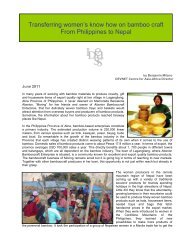
![[M077] Molino de viento cretense-instalación - Ideassonline.org](https://img.yumpu.com/51119608/1/190x245/m077-molino-de-viento-cretense-instalacian-ideassonlineorg.jpg?quality=85)
![[E004] Secador solar para madera (Guatemala ) - Ideassonline.org](https://img.yumpu.com/50176079/1/190x245/e004-secador-solar-para-madera-guatemala-ideassonlineorg.jpg?quality=85)
